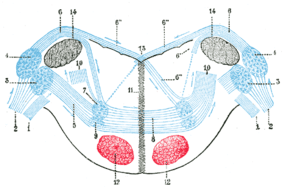Trapezoid body
The trapezoid body (the ventral acoustic stria) is part of the auditory pathway where some of the axons coming from the cochlear nucleus (specifically, the anterior cochlear nucleus) decussate (cross over) to the other side before traveling on to the superior olivary nucleus. This is believed to help with localization of sound.[1]
| Trapezoid body | |
|---|---|
 Terminal nuclei of the cochlear nerve, with their upper connections. (Schematic.) The vestibular nerve with its terminal nuclei and their efferent fibers have been suppressed. On the other hand, in order not to obscure the trapezoid body, the efferent fibers of the terminal nuclei on the right side have been resected in a considerable portion of their extent. The trapezoid body, therefore, shows only one-half of its fibers, viz., those that come from the left. 1. Vestibular nerve, divided at its entrance into the medulla oblongata. 2. Cochlear nerve. 3. Accessory nucleus of acoustic nerve. 4. Tuberculum acusticum. 5. Efferent fibers of accessory nucleus. 6. Efferent fibers of tuberculum acusticum, forming the striae medullares, with 6’, their direct bundle going to the superior olivary nucleus of the same side; 6’’, their decussating bundles going to the superior olivary nucleus of the opposite side. 7. Superior olivary nucleus. 8. Trapezoid body. 9. Trapezoid nucleus. 10. Lateral lemniscus. 11. Raphé. 12. Pyramidal tracts. 13. Fourth ventricle. 14. Inferior peduncle. | |
| Details | |
| Identifiers | |
| Latin | corpus trapezoideum |
| MeSH | D065833 |
| NeuroNames | 594 |
| NeuroLex ID | birnlex_707 |
| TA | A14.1.05.315 |
| FMA | 72487 |
| Anatomical terms of neuroanatomy | |
The trapezoid body is located in the caudal pons, or more specifically the pontine tegmentum. It is situated between the pontine nuclei and the medial lemniscus. After nerves from the cochlear nucleus cross over in the trapezoid body and go on to the superior olivary nucleus, they continue to the lateral lemniscus, then the inferior colliculus, then the medial geniculate body, before finally arriving at the primary auditory cortex.[2]
References
- Mendoza, John E. (2011). "Trapezoid Body". In Jeffrey S. Kreutzer; John DeLuca; Bruce Caplan (eds.). Encyclopedia of Clinical Neuropsychology. Springer New York. p. 2549. doi:10.1007/978-0-387-79948-3_807. ISBN 978-0-387-79947-6.
- Waxman, Stephen (2013-08-02). Clinical Neuroanatomy 27/E (27 ed.). New York: McGraw-Hill Medical. ISBN 9780071797979.